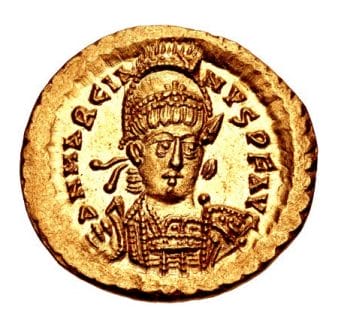Last Updated on November 27, 2023 by Vladimir Vulic
Life: AD 392 – 457

- Name: Marcianus
- Born in AD 392.
- Became emperor March AD 450.
- Died at Constantinople, AD 457.
Marcian was born in AD 392, the son of a Thracian or Illyrian soldier.
He, too, enrolled as a soldier (at Philippopolis) and in AD 421 he served against the Persians.
After this he served for fifteen years as a commander under Ardaburius and his son Aspar.
In AD 431 to 434 this service took him to Africa under the command of Aspar, where even was a captive of the Vandals for a time before being released again.
With the death of Theodosius II, who had no heirs of his own, power over the eastern empire should have fallen to the western emperor Valentinian III, leaving it for him to decide if he wanted to rule alone or appoint another eastern emperor. However, relations between east and west were not that good and both the court and the people of Constantinople would have objected to being ruled by a western emperor.
Theodosius II himself was also known to have been opposed to this and on his death bed, he is to have said to Marcian who was present alongside Aspar (Aspar was ‘Master of Soldiers’, but an Arian Christian and hence not a suitable candidate for the throne),
‘It has been revealed to me that you will reign after me.’
Theodosius II’s will was obeyed and Marcian did succeed him as emperor in AD 450.
Pulcheria, Theodosius II’s sister, agreed to marry Marcian, who was a widower, in order to thereby formally connect him with the dynasty of the House of Valentinian.
Valentinian III in the west though at first refused to recognize the accession of the eastern throne by Marcian, but later accepted the decision.
Marcian’s first act as emperor was to order Chrysaphius Zstommas to be put to death. He was a deeply unpopular advisor to Theodosius II and an enemy of Pulcheria.
Also he at once cancelled the subsidies paid to Attila the Hun, stating, ‘I have iron for Attila, but no gold.’
In AD 451 the Ecumenical Council of the Church at Chalcedon was held, which was to define the creed which is still the basis of religious teaching for the Eastern Orthodox Church today.
Although parts of pope Leo I’s demands were incorporated in the final agreement of the council, this council was a defining moment in the division between the eastern and the western Christian church.
Pulcheria died in 453, leaving her few belongings to the poor.
Marcian’s reign was largely free from any military or political crisis, such which befell the west.
In some cases his lack of military intervention did draw criticism. Particularly when he decided, on the advice of Aspar, not to intervene against the Vandals’ sack of Rome.
But apart from such criticism, Marcian proved a very able administrator. Not least because of the cancellation of tribute payments to the Huns, but so too, due to many reforms introduced by Marcian did the financial situation of Constantinople was much improved.
Early in AD 457 Marcian fell ill and after a five month illness he died. He was sincerely mourned by the people of Constantinople who saw his reign as a golden age.

Historian Franco Cavazzi dedicated hundreds of hours of his life to creating this website, roman-empire.net as a trove of educational material on this fascinating period of history. His work has been cited in a number of textbooks on the Roman Empire and mentioned on numerous publications such as the New York Times, PBS, The Guardian, and many more.
